Experiences and perspectives of in-service teachers of english at lower secondary schools towards the practice of culture teaching in english language classrooms
This paper looks into the experiences and perspectives of teachers of English at lower
secondary schools towards the practice of teaching culture in their classrooms. Data were collected
quantitatively and qualitatively through semi-open questionnaires and group interviews with 45 teachers
of lower secondary schools in a city in the north of Vietnam. It was primarily discovered that, although
most of the informants had many years of teaching experience, and the conditions for teaching cultural
contents in their classes were believed to be rather favorable, these teachers found it hard for them to
actually implement culture teaching due to the lack of skills at exploring cultural contents in textbooks
and conducting suitable in-class activities. Recommendations are made regarding professional
development programs for in-service teachers of English at secondary schools in Vietnam in the future.
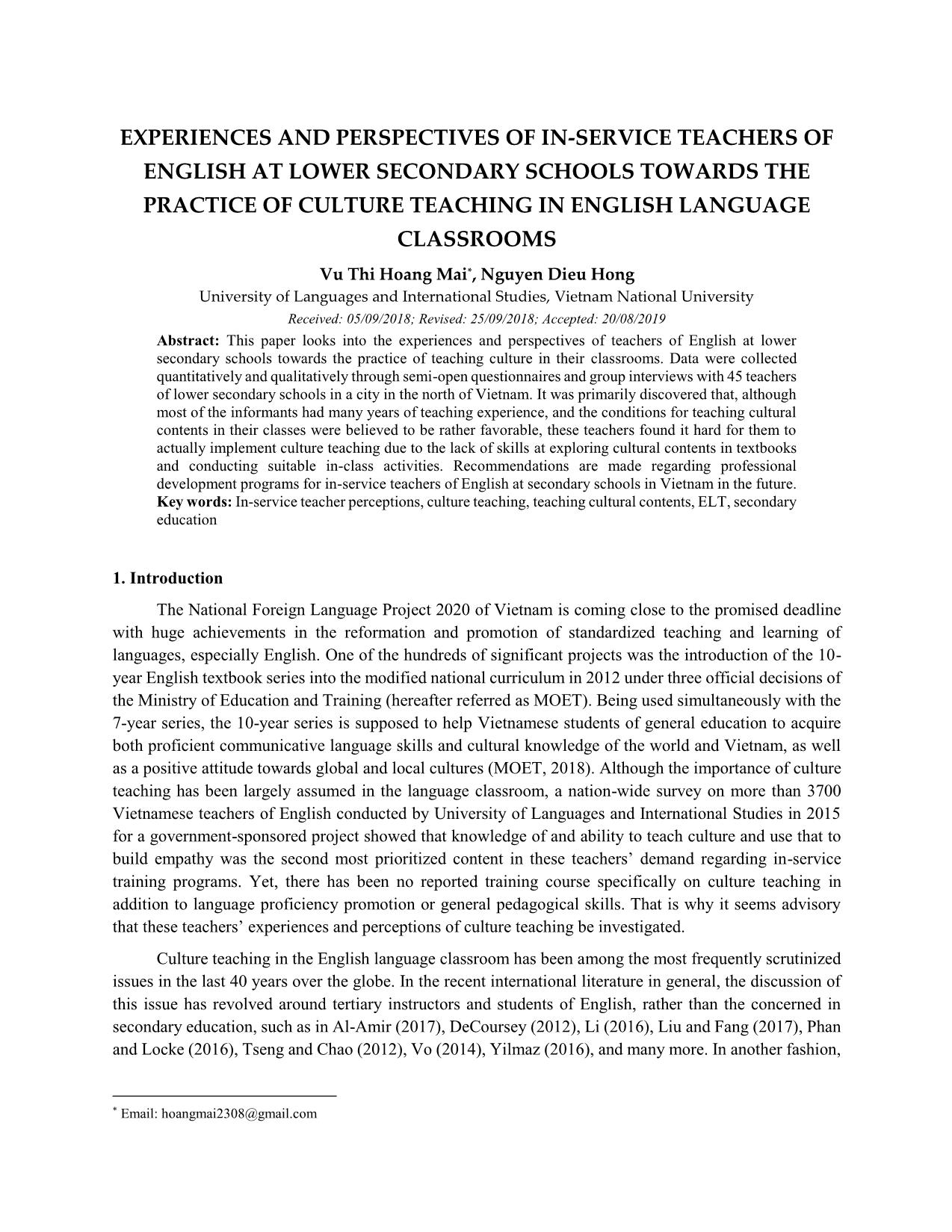
Trang 1
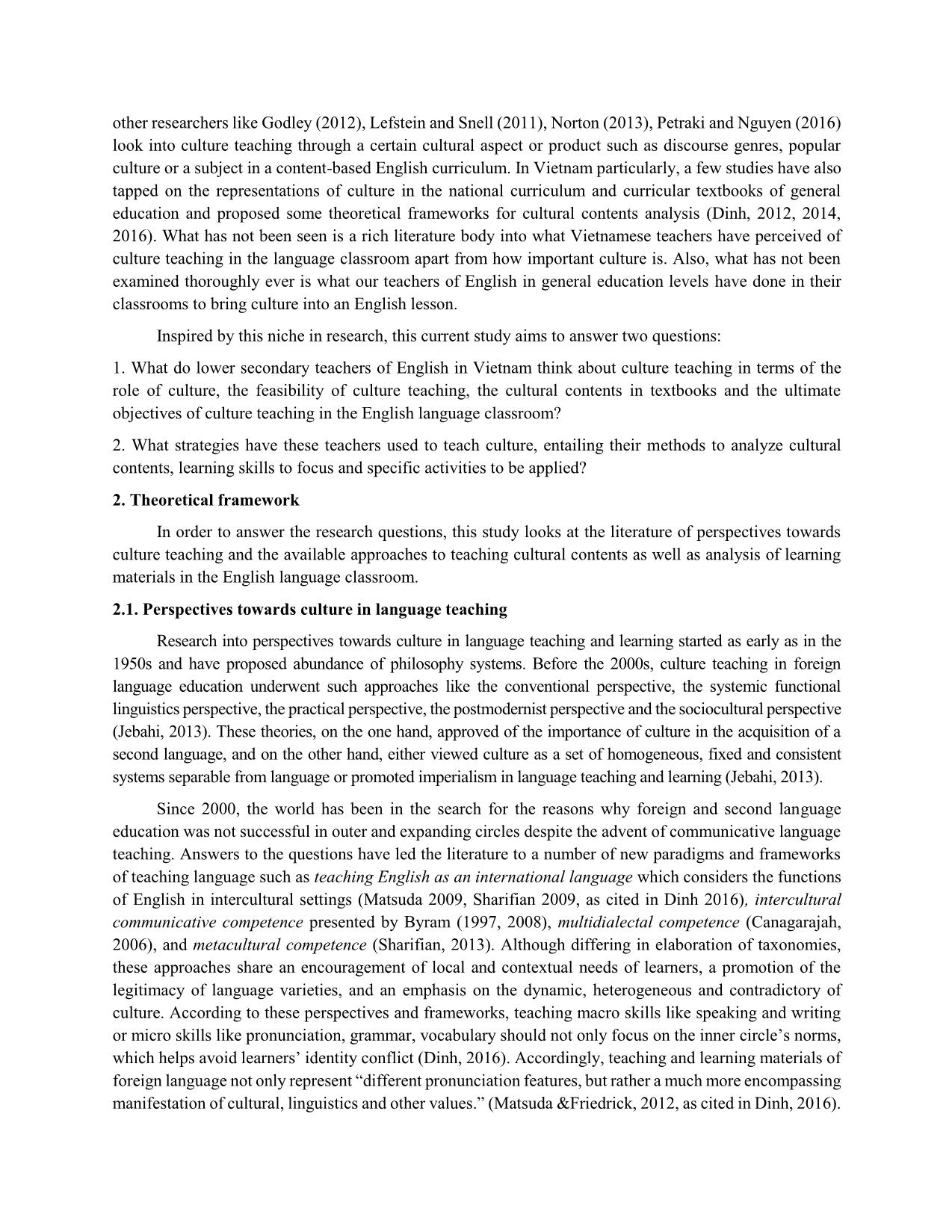
Trang 2
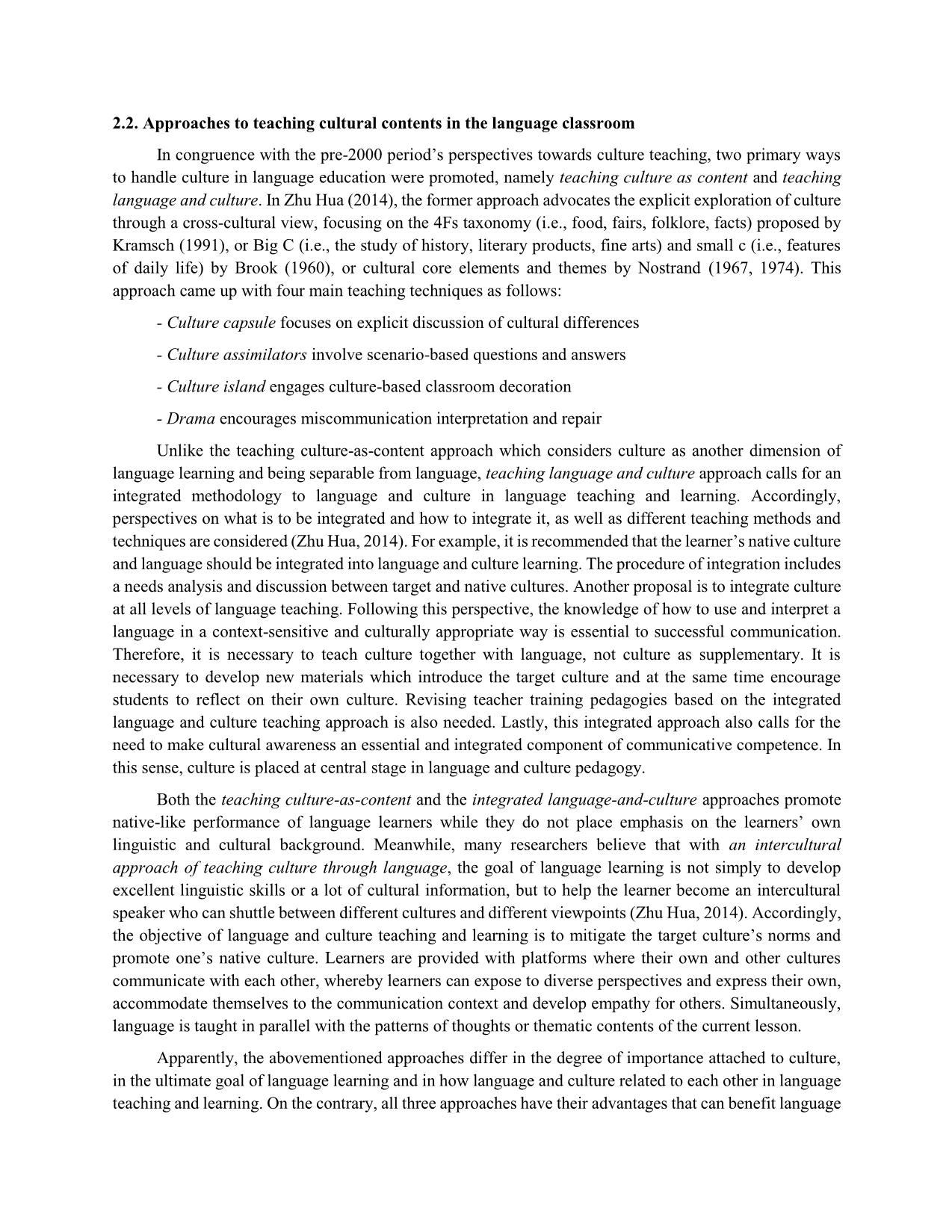
Trang 3
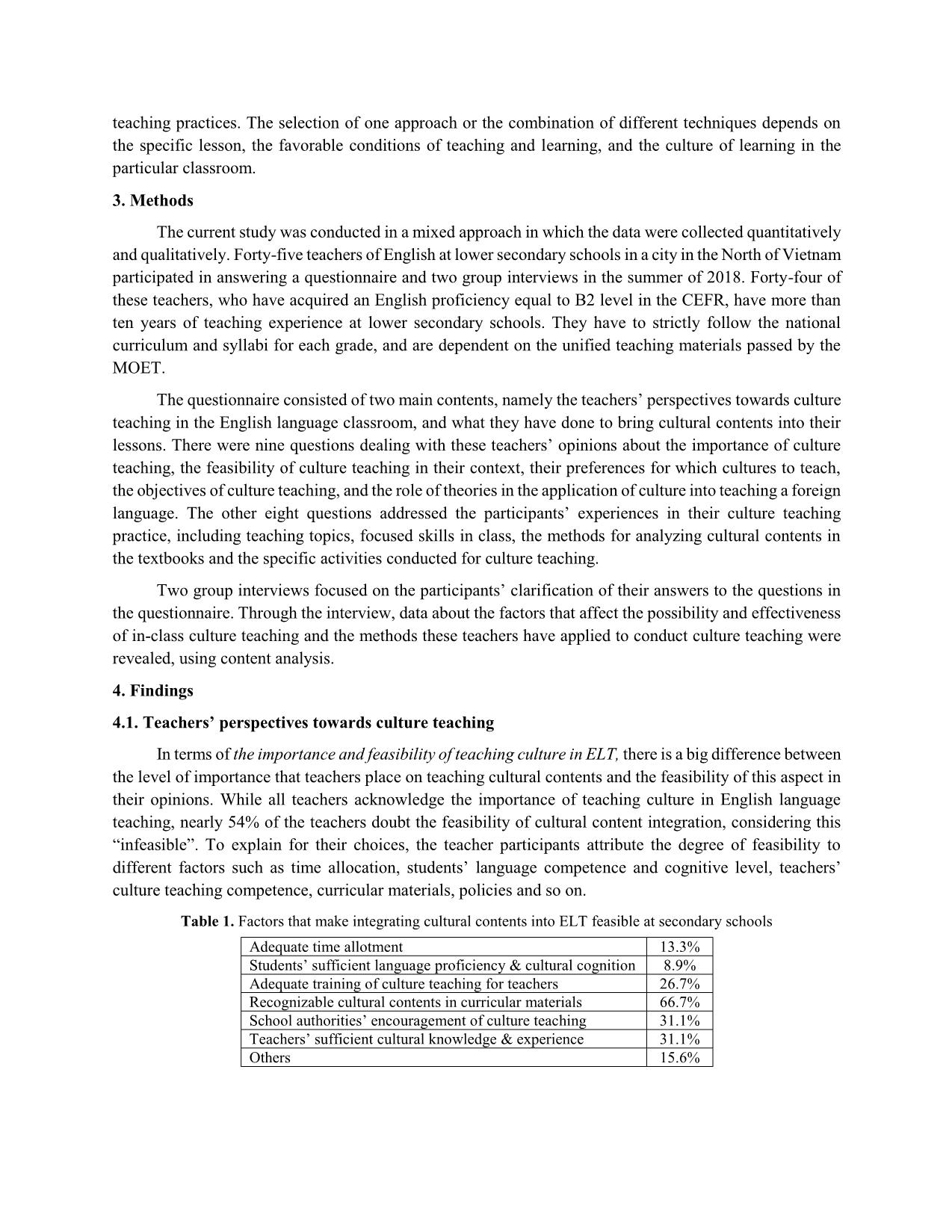
Trang 4
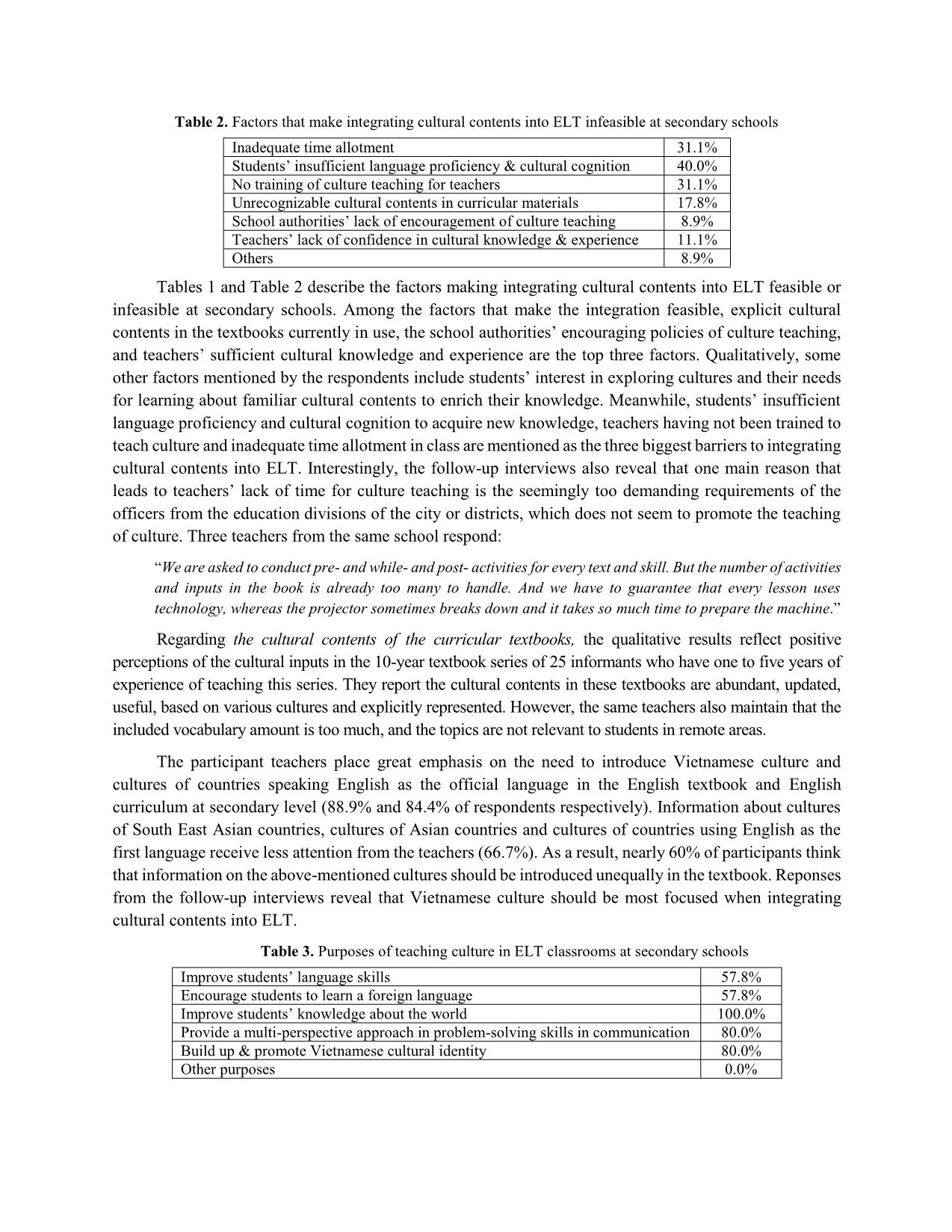
Trang 5

Trang 6

Trang 7
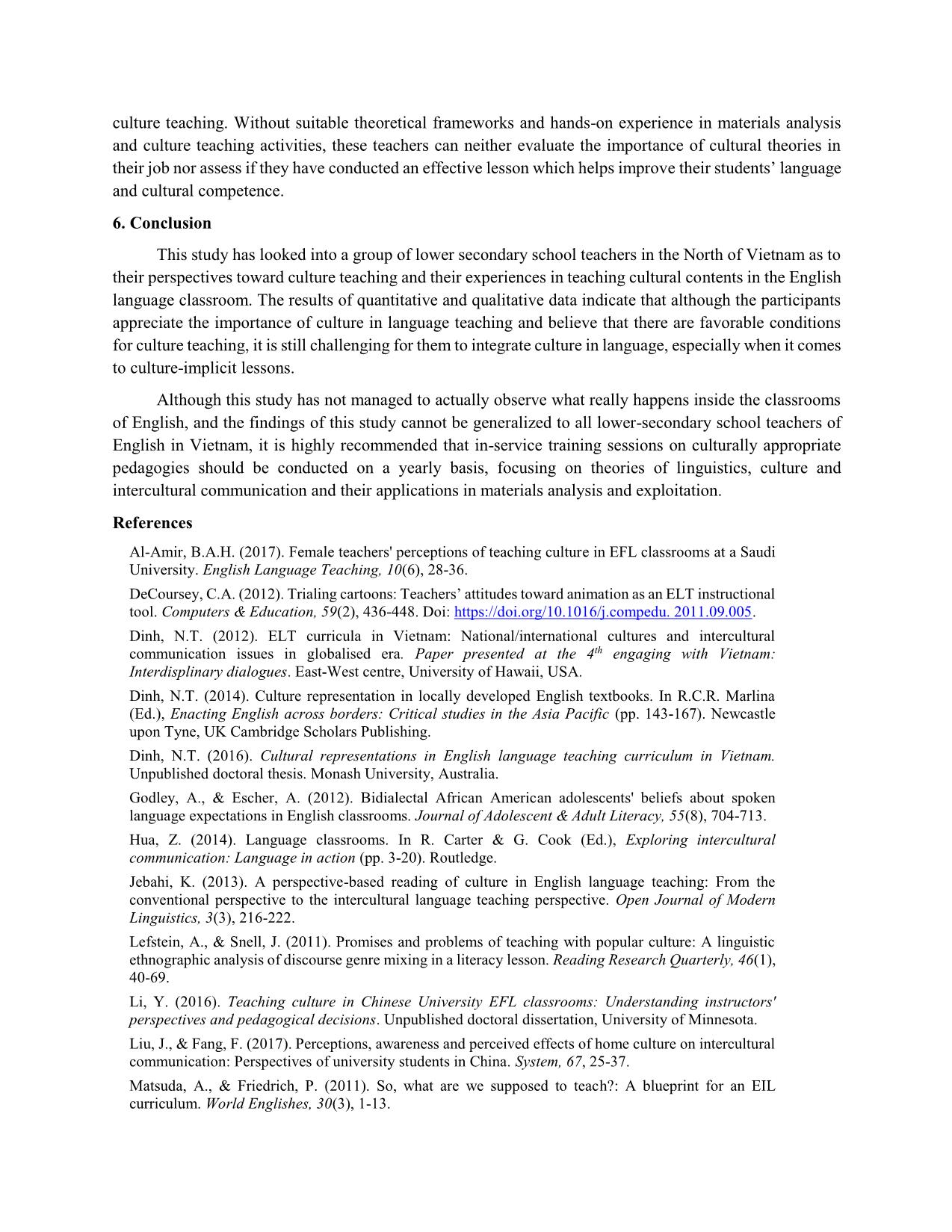
Trang 8
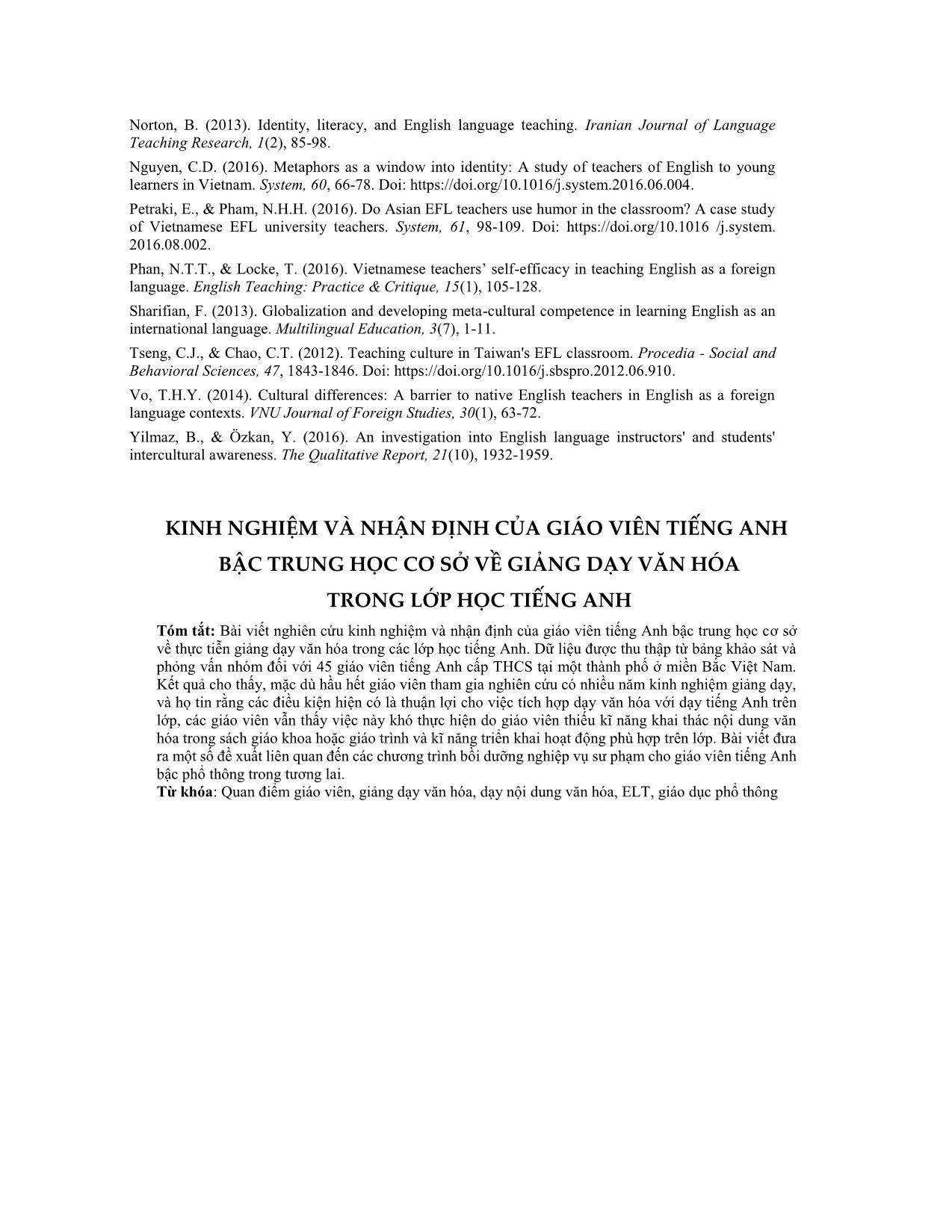
Trang 9
Tóm tắt nội dung tài liệu: Experiences and perspectives of in-service teachers of english at lower secondary schools towards the practice of culture teaching in english language classrooms
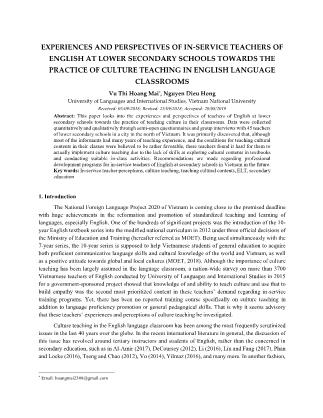
EXPERIENCES AND PERSPECTIVES OF IN-SERVICE TEACHERS OF ENGLISH AT LOWER SECONDARY SCHOOLS TOWARDS THE PRACTICE OF CULTURE TEACHING IN ENGLISH LANGUAGE CLASSROOMS Vu Thi Hoang Mai*, Nguyen Dieu Hong University of Languages and International Studies, Vietnam National University Received: 05/09/2018; Revised: 25/09/2018; Accepted: 20/08/2019 Abstract: This paper looks into the experiences and perspectives of teachers of English at lower secondary schools towards the practice of teaching culture in their classrooms. Data were collected quantitatively and qualitatively through semi-open questionnaires and group interviews with 45 teachers of lower secondary schools in a city in the north of Vietnam. It was primarily discovered that, although most of the informants had many years of teaching experience, and the conditions for teaching cultural contents in their classes were believed to be rather favorable, these teachers found it hard for them to actually implement culture teaching due to the lack of skills at exploring cultural contents in textbooks and conducting suitable in-class activities. Recommendations are made regarding professional development programs for in-service teachers of English at secondary schools in Vietnam in the future. Key words: In-service teacher perceptions, culture teaching, teaching cultural contents, ELT, secondary education 1. Introduction The National Foreign Language Project 2020 of Vietnam is coming close to the promised deadline with huge achievements in the reformation and promotion of standardized teaching and learning of languages, especially English. One of the hundreds of significant projects was the introduction of the 10- year English textbook series into the modified national curriculum in 2012 under three official decisions of the Ministry of Education and Training (hereafter referred as MOET). Being used simultaneously with the 7-year series, the 10-year series is supposed to help Vietnamese students of general education to acquire both proficient communicative language skills and cultural knowledge of the world and Vietnam, as well as a positive attitude towards global and local cultures (MOET, 2018). Although the importance of culture teaching has been largely assumed in the language classroom, a nation-wide survey on more than 3700 Vietnamese teachers of English conducted by University of Languages and International Studies in 2015 for a government-sponsored project showed that knowledge of and ability to teach culture and use that to build empathy was the second most prioritized content in these teachers’ demand regarding in-service training programs. Yet, there has been no reported training course specifically on culture teaching in addition to language proficiency promotion or general pedagogical skills. That is why it seems advisory that these teachers’ experiences and perceptions of culture teaching be investigated. Culture teaching in the English language classroom has been among the most frequently scrutinized issues in the last 40 years over the globe. In the recent international literature in general, the discussion of this issue has revolved around tertiary instructors and students of English, rather than the concerned in secondary education, such as in Al-Amir (2017), DeCoursey (2012), Li (2016), Liu and Fang (2017), Phan and Locke (2016), Tseng and Chao (2012), Vo (2014), Yilmaz (2016), and many more. In another fashion, * Email: hoangmai2308@gmail.com other researchers like Godley (2012), Lefstein and Snell (2011), Norton (2013), Petraki and Nguyen (2016) look into culture teaching through a certain cultural aspect or product such as discourse genres, popular culture or a subject in a content-based English curriculum. In Vietnam particularly, a few studies have also tapped on the representations of culture in the national curriculum and curricular textbooks of general education and proposed some theoretical frameworks for cultural contents analysis (Dinh, 2012, 2014, 2016). What has not been seen is a rich literature body into what Vietnamese teachers have perceived of culture teaching in the language classroom apart from how important culture is. Also, what has not been examined thoroughly ever is what our teachers of English in general education levels have done in their classrooms to bring culture into an English lesson. Inspired by this niche in research, this current study aims to answer two questions: 1. What do lower secondary teachers of English in Vietnam think about culture teaching in terms of the role of culture, the feasibility of culture teaching, the cultural contents in textbooks and the ultimate objectives of culture teaching in the English language classroom? 2. What strategies have these teachers used to teach culture, entailing their methods to analyze cultural contents, learning skills to focus and specific activities to be applied? 2. Theoretical framework In order to answer the research questions, this study looks at the literature of perspectives towards culture teaching and the available approaches to teaching cultural contents as well as analysis of learning materials in the English language classroom. 2.1. Perspectives towards culture in language teaching Research into perspectives towards culture in language teaching and learning started as early as in the 1950s and have proposed abundance of philosophy systems. Before the 2000s, culture teaching in foreign language education underwent such approaches like the conventional perspective, the systemic functional linguistics perspective, the practical perspective, the postmodernist perspective and the sociocultural perspective (Jebahi, 2013). These theories, on the one hand, approved of the importance of culture in the acquisition of a second language, and on the other hand, either viewed culture as a set of homogeneous, fixed a ... rage students to learn a foreign language 57.8% Improve students’ knowledge about the world 100.0% Provide a multi-perspective approach in problem-solving skills in communication 80.0% Build up & promote Vietnamese cultural identity 80.0% Other purposes 0.0% According to the participants, teaching culture in ELT classrooms serves various purposes; however, the primary purpose is to improve students’ knowledge about the world (100%). Building up and promoting the Vietnamese cultural identity and providing a multi-perspective approach in problem-solving skills in communication rank second with 80% of responses. 4.2. Teachers’ practice of culture teaching The participants have different priorities in selecting topics to teach cultural contents. Family, festivals, customs and traditions, and education are the most widely chosen, while science and technology, press and media as well as law are among the least likely selected topics. The main reason for not choosing certain topics to teach culture is that teachers do not know how to explore and integrate such contents in their class. Some teachers inform in the interviews that some topics in the curricular textbooks require broad background knowledge which does not seem to meet the communicative needs of lower secondary school students. Table 4. Topics in English textbooks usually selected to teach cultural contents Family 88.9% Science and technology 17.8% Ethnicity 66.7% Education 66.7% Language 66.7% Health and healthcare 44.4% Geography 40.0% Social relationships 62.2% History 46.7% Law 35.6% Festivals, customs & traditions 100.0% Press and Media 22.2% Daily habits 80.0% Famous people 44.4% Energy sources and environment 40.0% Other topics 0.0% As for the channels that teachers employ to teach culture, illustrated pictures and cultural information included in the text are mostly used (44.4%). It should be noted that students’ cultural knowledge and experience is a much more widely used channel than teachers’ knowledge and experience, with 35.6% and 8.9% of responses respectively. Table 5. Languages skills usually integrated with cultural contents Listening 44.4% Reading 95.6% Speaking 82.2% Writing 53.3% Table 6. Reasons for choosing certain skills to teach cultural contents Texts for taught skill have explicit cultural input. 48.9% The skill allows easier conduct of learning activities with cultural contents 88.9% Others 0.0% Tables 5 and Table 6 describe the percentage of language skills teachers usually use to combine with teaching cultural contents and the reasons why they choose such skills. In practice, most teachers usually integrate cultural content into teaching Reading and Speaking (95.6% and 82.2% respectively), while about half of the participants also choose to teach culture in their Listening and Writing lessons. The main reason for choosing certain skills to integrate cultural contents is that such skills seem to be more easily to be combined with cultural contents than the other skills do. However, 100% of respondents do not apply any cultural and intercultural theories in teaching cultural contents, claiming they do not know any of them. A majority of teachers are not sure about the necessity of using cultural/intercultural frameworks in their teaching while a third think such frameworks are needed. Therefore, training sessions on how to explore cultural contents in English textbooks are most anticipated (93.3% of responses). Procedure to teach culture, cultural information about specific cultures and cultural/intercultural theories come next with 75.6%, 71.1% and 57.8% of responses respectively. As to the specific techniques that these teachers use to explore cultural contents in the textbooks and to conduct culture teaching, the follow-up interviews document tens of in-class activities such as “brainstorming”, “showing cultural video clips”, “discussion on cultures”, “predictions”, “students associating lesson contents with their own culture”, “quiz”, “question and answer”, “what and where”, “pair work”, “group work”, and many more. What is noticeable is that these answers seem very ambiguous in terms of dealing specifically with culture. Moreover, there is no answer to what techniques or methods have been used to analyze and explore cultural contents in the textbooks. 5. Discussion and implications As clearly stated in the findings of the study, despite the teachers’ absolute agreement on the importance of culture teaching, the majority of them find it impossible to properly conduct a culture- integrated English lesson due to the lack of resources like time, encouraging policies or teachers and students’ readiness. This seems to reflect the perspectives of teaching foreign language before 2000, which considered culture as separable contents from language. Because of this view, both teachers and their direct supervisors either think it is too much to teach culture or neglect cultural contents altogether. It is advisable to inform these education practitioners of such modern paradigms as English as an international language, intercultural communicative competence, multidialectal competence and metacultural competence, since they see culture as inextricably intertwined with language, implicitly implied or explicitly embedded in grammar, vocabulary, and discourse. These paradigms can provide teachers with pluricentric approaches to explore and teach culture. Moreover, an appropriate evaluation of the 10-year textbook series is also necessary for these teachers and their supervisors so as to help them get rid of confused and intimidated feelings when exposed to the densely displayed contents of the books. In fact, it is not necessary to conduct pre-, while- and post- activities for every text or skill because the abundant activities available in the books per se have been designed for exactly these same purposes. What teachers need to do may be to approach a lesson in a different way from the book itself. On the contrary, it is also implied that these teachers start to realize the important relevance and legitimacy of local cultures to the Vietnamese learners in their support of the surpassing content of Vietnamese culture compared with the culture of English-speaking countries and their perceived objectives of teaching culture to promote the Vietnamese identity and students’ communicative competence. This is a sign of teachers’ readiness that undergirds the establishment of in-service training programs dealing with culturally responsible pedagogies. The practice of culture teaching of the participants so far on the one hand indicates that the approaches of teaching culture-as-content and teaching language-and-culture have been applied in their classrooms. The culture-explicit topics and skills, the techniques of cultural capsule and cultural assimilators are the most frequently applied. This reality implies another perspective to culture teaching of the informants: they prefer to have a ready-to-use tool or culture-explicit materials to support their lessons, and some even have the tendency to select what is convenient for their job and what they are confident in to teach instead of working on what is advantageous for their students’ intercultural competence. On the other hand, it is also shown from the data that these teachers really need official training about theories of intercultural communication, cultural linguistics and their application in cultural studies and culture teaching. Without suitable theoretical frameworks and hands-on experience in materials analysis and culture teaching activities, these teachers can neither evaluate the importance of cultural theories in their job nor assess if they have conducted an effective lesson which helps improve their students’ language and cultural competence. 6. Conclusion This study has looked into a group of lower secondary school teachers in the North of Vietnam as to their perspectives toward culture teaching and their experiences in teaching cultural contents in the English language classroom. The results of quantitative and qualitative data indicate that although the participants appreciate the importance of culture in language teaching and believe that there are favorable conditions for culture teaching, it is still challenging for them to integrate culture in language, especially when it comes to culture-implicit lessons. Although this study has not managed to actually observe what really happens inside the classrooms of English, and the findings of this study cannot be generalized to all lower-secondary school teachers of English in Vietnam, it is highly recommended that in-service training sessions on culturally appropriate pedagogies should be conducted on a yearly basis, focusing on theories of linguistics, culture and intercultural communication and their applications in materials analysis and exploitation. References Al-Amir, B.A.H. (2017). Female teachers' perceptions of teaching culture in EFL classrooms at a Saudi University. English Language Teaching, 10(6), 28-36. DeCoursey, C.A. (2012). Trialing cartoons: Teachers’ attitudes toward animation as an ELT instructional tool. Computers & Education, 59(2), 436-448. Doi: https://doi.org/10.1016/j.compedu. 2011.09.005. Dinh, N.T. (2012). ELT curricula in Vietnam: National/international cultures and intercultural communication issues in globalised era. Paper presented at the 4th engaging with Vietnam: Interdisplinary dialogues. East-West centre, University of Hawaii, USA. Dinh, N.T. (2014). Culture representation in locally developed English textbooks. In R.C.R. Marlina (Ed.), Enacting English across borders: Critical studies in the Asia Pacific (pp. 143-167). Newcastle upon Tyne, UK Cambridge Scholars Publishing. Dinh, N.T. (2016). Cultural representations in English language teaching curriculum in Vietnam. Unpublished doctoral thesis. Monash University, Australia. Godley, A., & Escher, A. (2012). Bidialectal African American adolescents' beliefs about spoken language expectations in English classrooms. Journal of Adolescent & Adult Literacy, 55(8), 704-713. Hua, Z. (2014). Language classrooms. In R. Carter & G. Cook (Ed.), Exploring intercultural communication: Language in action (pp. 3-20). Routledge. Jebahi, K. (2013). A perspective-based reading of culture in English language teaching: From the conventional perspective to the intercultural language teaching perspective. Open Journal of Modern Linguistics, 3(3), 216-222. Lefstein, A., & Snell, J. (2011). Promises and problems of teaching with popular culture: A linguistic ethnographic analysis of discourse genre mixing in a literacy lesson. Reading Research Quarterly, 46(1), 40-69. Li, Y. (2016). Teaching culture in Chinese University EFL classrooms: Understanding instructors' perspectives and pedagogical decisions. Unpublished doctoral dissertation, University of Minnesota. Liu, J., & Fang, F. (2017). Perceptions, awareness and perceived effects of home culture on intercultural communication: Perspectives of university students in China. System, 67, 25-37. Matsuda, A., & Friedrich, P. (2011). So, what are we supposed to teach?: A blueprint for an EIL curriculum. World Englishes, 30(3), 1-13. Norton, B. (2013). Identity, literacy, and English language teaching. Iranian Journal of Language Teaching Research, 1(2), 85-98. Nguyen, C.D. (2016). Metaphors as a window into identity: A study of teachers of English to young learners in Vietnam. System, 60, 66-78. Doi: https://doi.org/10.1016/j.system.2016.06.004. Petraki, E., & Pham, N.H.H. (2016). Do Asian EFL teachers use humor in the classroom? A case study of Vietnamese EFL university teachers. System, 61, 98-109. Doi: https://doi.org/10.1016 /j.system. 2016.08.002. Phan, N.T.T., & Locke, T. (2016). Vietnamese teachers’ self-efficacy in teaching English as a foreign language. English Teaching: Practice & Critique, 15(1), 105-128. Sharifian, F. (2013). Globalization and developing meta-cultural competence in learning English as an international language. Multilingual Education, 3(7), 1-11. Tseng, C.J., & Chao, C.T. (2012). Teaching culture in Taiwan's EFL classroom. Procedia - Social and Behavioral Sciences, 47, 1843-1846. Doi: https://doi.org/10.1016/j.sbspro.2012.06.910. Vo, T.H.Y. (2014). Cultural differences: A barrier to native English teachers in English as a foreign language contexts. VNU Journal of Foreign Studies, 30(1), 63-72. Yilmaz, B., & Özkan, Y. (2016). An investigation into English language instructors' and students' intercultural awareness. The Qualitative Report, 21(10), 1932-1959. KINH NGHIỆM VÀ NHẬN ĐỊNH CỦA GIÁO VIÊN TIẾNG ANH BẬC TRUNG HỌC CƠ SỞ VỀ GIẢNG DẠY VĂN HÓA TRONG LỚP HỌC TIẾNG ANH Tóm tắt: Bài viết nghiên cứu kinh nghiệm và nhận định của giáo viên tiếng Anh bậc trung học cơ sở về thực tiễn giảng dạy văn hóa trong các lớp học tiếng Anh. Dữ liệu được thu thập từ bảng khảo sát và phỏng vấn nhóm đối với 45 giáo viên tiếng Anh cấp THCS tại một thành phố ở miền Bắc Việt Nam. Kết quả cho thấy, mặc dù hầu hết giáo viên tham gia nghiên cứu có nhiều năm kinh nghiệm giảng dạy, và họ tin rằng các điều kiện hiện có là thuận lợi cho việc tích hợp dạy văn hóa với dạy tiếng Anh trên lớp, các giáo viên vẫn thấy việc này khó thực hiện do giáo viên thiếu kĩ năng khai thác nội dung văn hóa trong sách giáo khoa hoặc giáo trình và kĩ năng triển khai hoạt động phù hợp trên lớp. Bài viết đưa ra một số đề xuất liên quan đến các chương trình bồi dưỡng nghiệp vụ sư phạm cho giáo viên tiếng Anh bậc phổ thông trong tương lai. Từ khóa: Quan điểm giáo viên, giảng dạy văn hóa, dạy nội dung văn hóa, ELT, giáo dục phổ thông
File đính kèm:
 experiences_and_perspectives_of_in_service_teachers_of_engli.pdf
experiences_and_perspectives_of_in_service_teachers_of_engli.pdf

